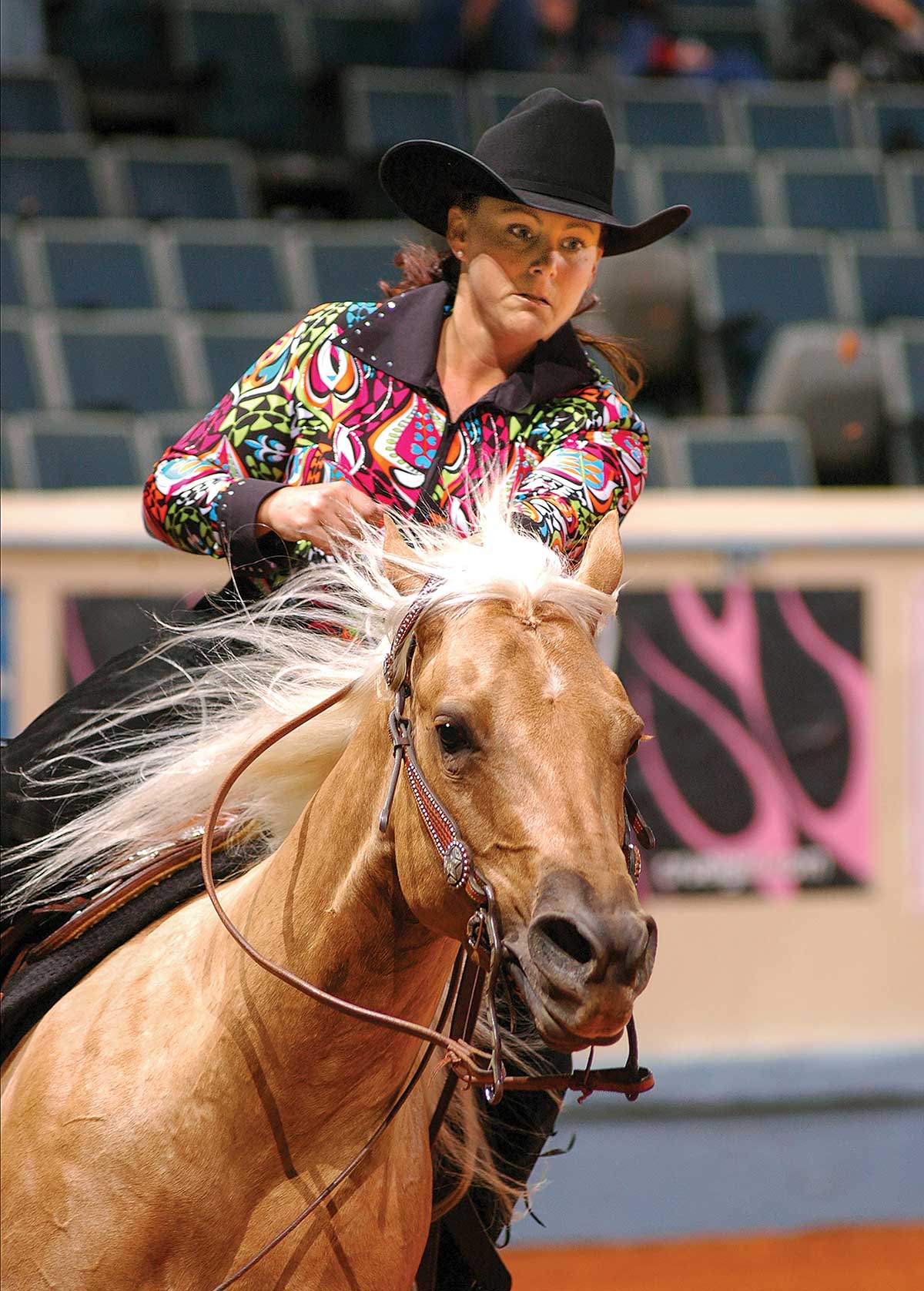
Competitors all dream of winning on the big stage. For reiners, that’s often at the Jim Norick Arena in Oklahoma City during either the National Reining Horse Association Derby or Futurity. Riders and trainers fantasize about being crowned the NRHA Futurity Champion, the penultimate title. Breeders hope they’ve produced the next prospect to wear the roses. Owners dream of taking those roses home to their mantels. It’s a lofty goal for a DIY rider.
Rarely are all four of those people—rider, trainer, breeder, and owner—under one hat. But when you’re the ultimate do-it-yourself non-pro, the stars can align for that to occur, as they did for Sandra Bentien at the 2016 NRHA Futurity.
Make Believe
Sandra doesn’t remember a time when she wasn’t horse crazy—it was literally love at first sight when she saw her first horse at age 3. When she turned 5, her dad and grandfather brought home for her a black Shetland pony she named Thunder.
“It was the best day of my life,” Sandra recalls.
That memorable day spurred on a friendship that would mold Sandra into the horsewoman she is today. Sandra credits the tiny wonder with teaching her important lessons and filling empty spaces in her life.
Thunder would run along home next to Sandra every day, and he’d be her partner in any make-believe play action—from cowboys and Indians to playing horse show to being a famous racehorse and jockey. In what might’ve been a prelude to her future horse life, the precocious pony also taught Sandra about hard stops, most times dumping the young rider in the dirt.
“I spent hours every day riding bareback with a huge imagination,” she says. “There was nothing we couldn’t do.”
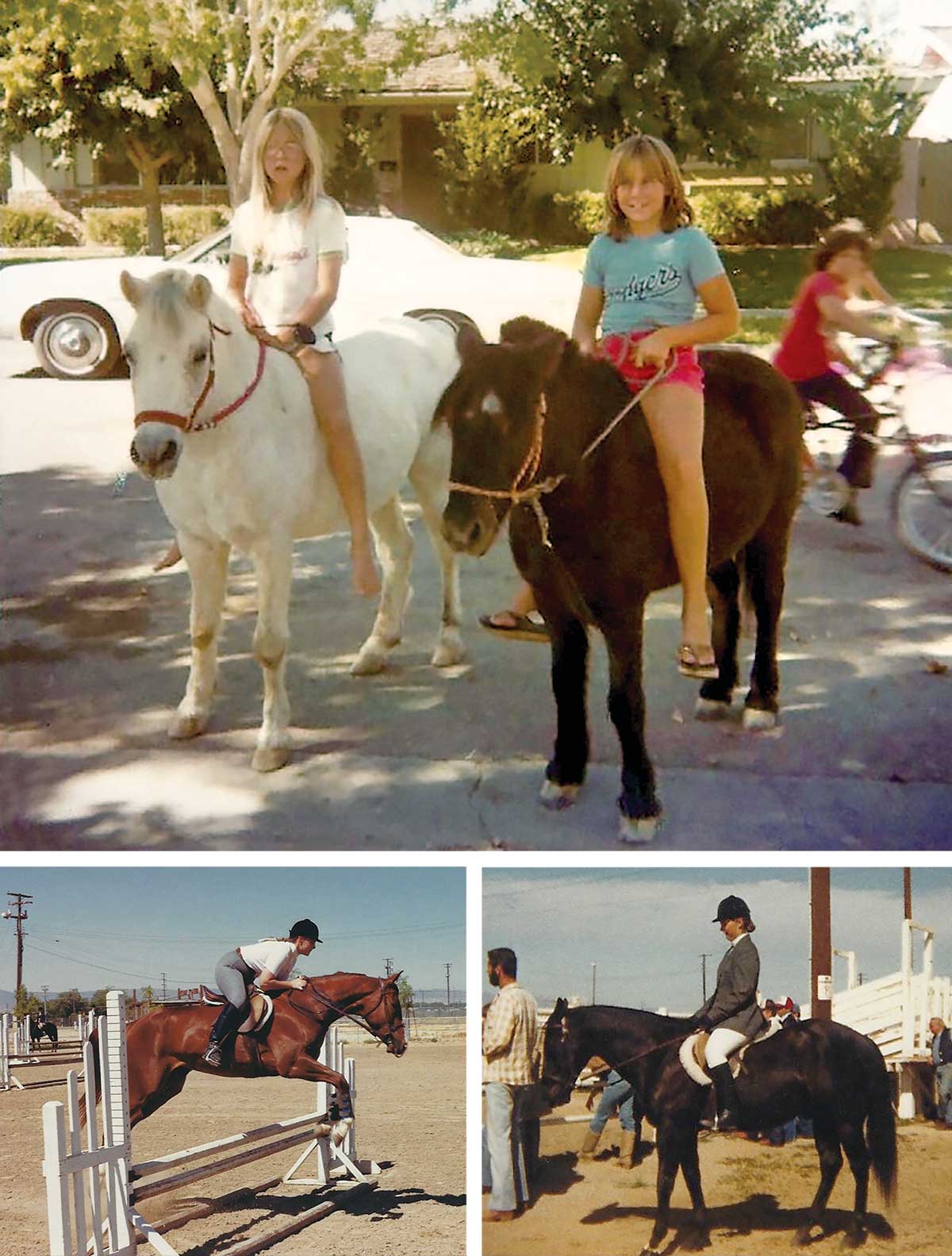
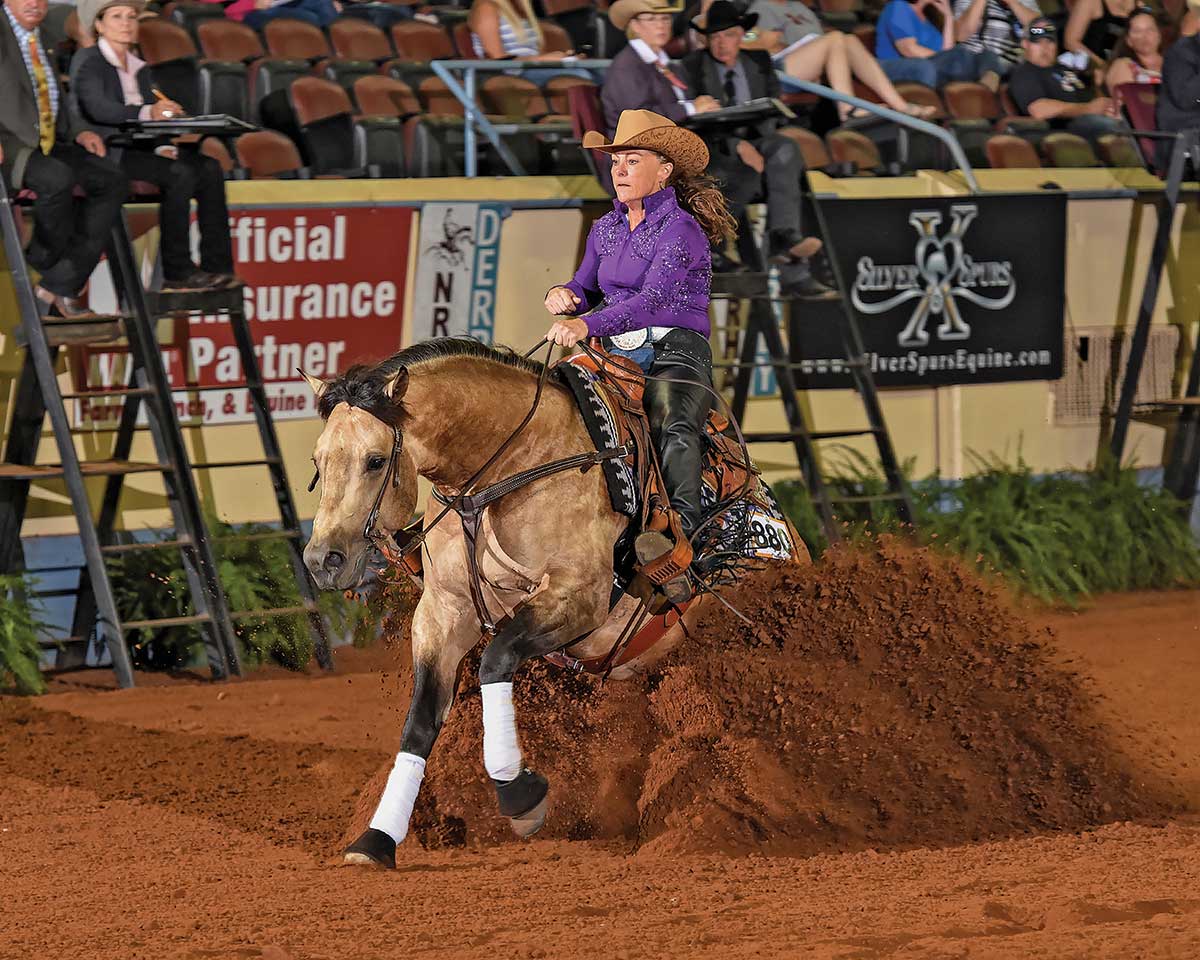
One of their usual excursions included a ride to the local boarding barn, where Sandra watched the “horse show girls” ride their trained Quarter Horses. “The girls were very nice to me, and sometimes they’d lead me around on their big horses,” she recalls. “Eventually, they’d allow me to walk and jog. I was about 8 years old when one of them invited me to show her horse in a couple walk-jog classes at a local open show.”
That day stoked the flames of her passion. After earning top-five finishes, Sandra wanted to show more, but her parents didn’t have the money for her to take lessons or get a fancy show horse.
“So my show career amounted to pretending on Thunder,” she says.
Over the next few years, Sandra’s dad brought home horses that he got cheap or as a trade-in at his car dealership. She remembers none of them being well-trained, and some were even dangerous, so they didn’t stay long on the family farm. At one point, her dad told her that if she wanted a better horse, she’d need to sell Thunder. Sandra refused.
“I rode that pony until my feet were practically dragging the ground,” Sandra laughs. “One day I rode up to my dad, who was with a bunch of his friends, and they started teasing my dad about not getting me a ‘big horse.’ My dad made me a deal—he’d match whatever I saved up to buy my own horse.”
Sandra took on odd jobs to save up $400. True to his word, her father matched her total. She used the funds to purchase an 8-year-old black Quarter Horse gelding named 3L Rackum Bar (or “38” as they called him, after Sandra’s dad’s favorite gun). The former ranch and barrel horse was quite the handful, but the 12-year-old equestrian was determined to make him a show horse.
“At times, I thought the prancing and head-tossing horse would never make a show horse,” she recalls. “He wore my patience like none other. He wasn’t a confident horse and was always very nervous, but he was what I had, and I was a determined young girl.”
Sandra read horse-training books, watched competitors in the warm-up arena, listened to trainers talk among themselves and with their clients, and absorbed everything like a sponge. “I’d think about what was being done and how it may affect the horse, and then go home and apply it to 38,” she says. “Eventually a change began to occur in the horse, and he started to blossom into a show horse.”
After that epiphany, the pair competed in showmanship, horsemanship, Western pleasure, English pleasure, and equitation, amassing many ribbons and year-end awards at local open and AQHA shows.
“He wasn’t a standout in any one event, but he was good in all of them,” she admits.
DIY Non-Pro Show Tips
Sandra Bentien has traveled across the United States showing at AQHA and NRHA shows, mostly on her own or while stalling with a professional. Even if she’s with a group, she’s responsible for everything she and her horse need to be successful that weekend.
“If you’re planning for a show or event, be prepared,” she advises. Here’s her prep list.
• Be prepared to arrive early or at least on time.
• Prior to the event, make a list of everything you’ll need.
• If you’re stabling overnight, order your shavings ahead of time so they’re at your stalls when you arrive.
• Have enough feed with you, or have it delivered early as well.
• Know the warm-up and show schedules.
• At the show, don’t override your horse. You want him happy to load in the trailer, so make the show less work and more fun.
• Learn how your horse likes to be prepared to show. Is he the kind that needs to be longed and allowed to play before getting saddled? Does he need to be worked until he’s a little tired, then taken back to his stall to drink and urinate? If might take multiple classes and shows to know what your horse likes to perform his best, but it’s worth the time and trouble.
Reality Check
During this time a local trainer took Sandra under her wing, with Sandra working off her occasional lessons at the barn. After a lot of thought, Sandra traded in 38 for a yearling Quarter Horse filly named Jiggy Bar Jasmine. At just 15, Sandra started her first horse under saddle.
“Starting a young horse was such an amazing confidence builder, and it was at this time I, myself, began to blossom,” she says. “I felt empowered teaching a horse and seeing the results. It was so exciting and rewarding for me.”
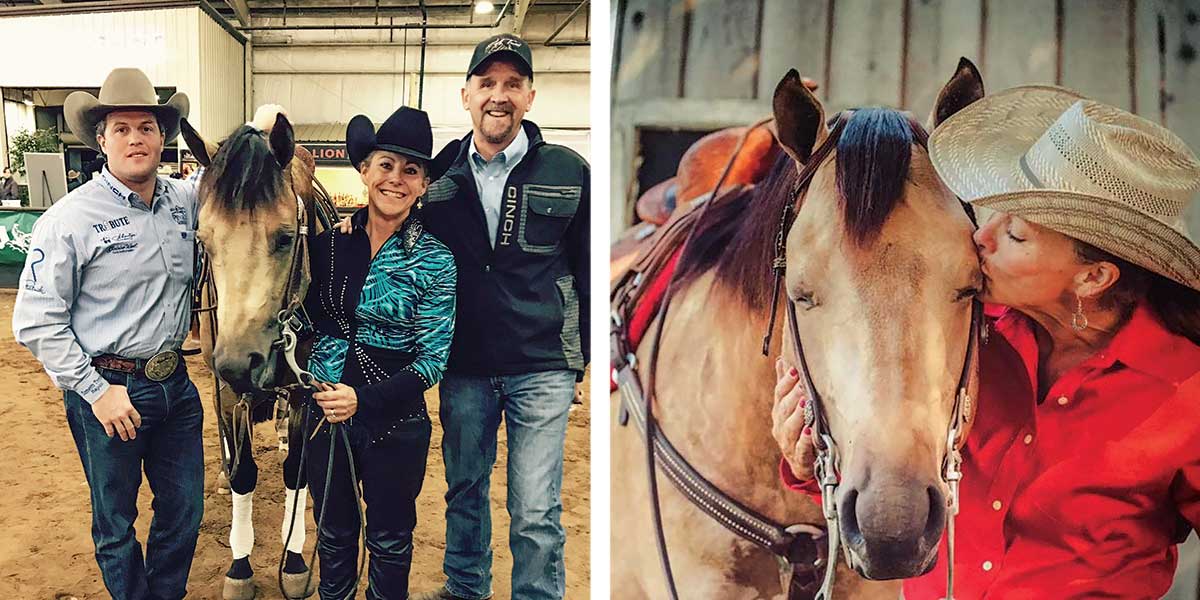
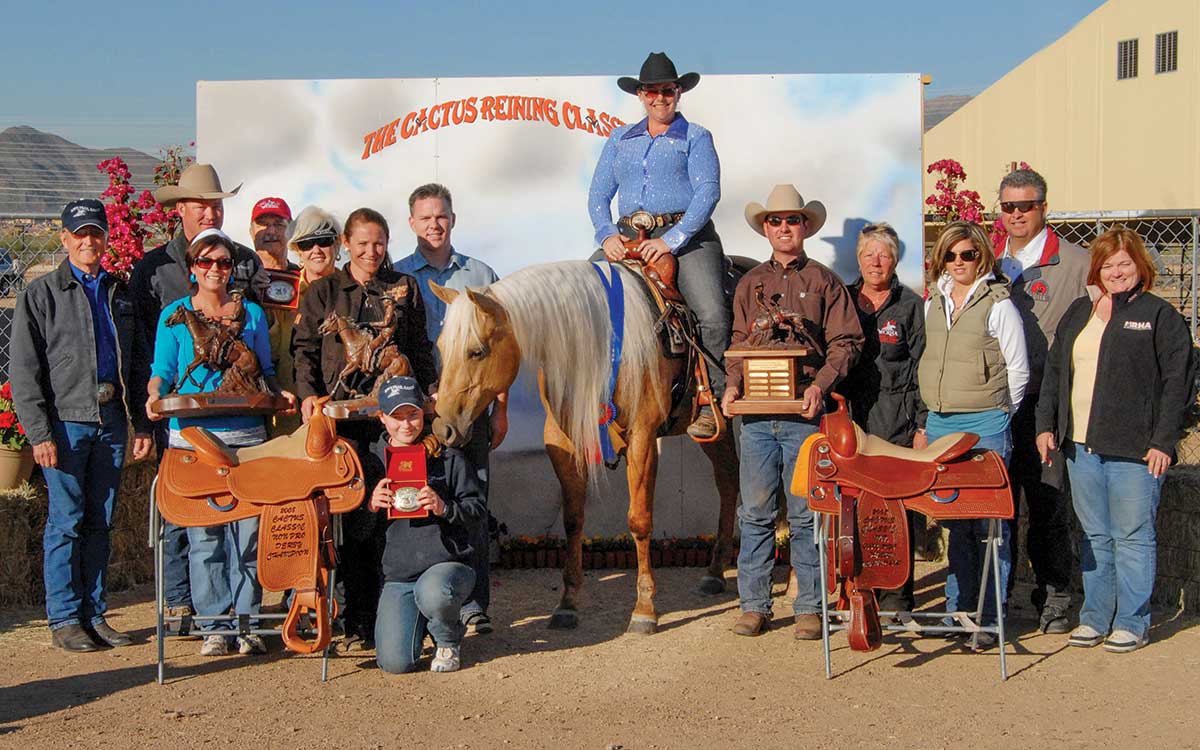
The pair successfully competed in all-around events through the years, until life happened. After getting married young, Sandra became pregnant. To stay active in the horse-show world, she decided to sell Jasmine and purchase a halter mare. “It was a bit easier fitting a halter horse than riding and training one with a baby,” she says.
After another successful endeavor, including trips to the AQHA Open and Amateur World Shows, Sandra and her family moved from their hometown in Lancaster, California, to follow her parents to Northern California. A friend was interested in her halter mare, so Sandra traded the halter horse for another mare. This one had been shown at the National Reined Cow Horse Association Snaffle Bit Futurity and was a good ranch-type horse, being a daughter of Dry Doc.
“She gave me my first taste of what a horse with a bit of reining handle felt like,” Sandra recalls. “I was hooked.”
And then life happened again. Sandra and her husband divorced, and she found herself working two jobs as a single mom. After getting remarried, she knew it was time to get her first real reiner. In January 2001, she purchased a 4-year-old stallion named Custom Slider from trainer Steve Simon.
“Slider set the bar high for my future in reining,” Sandra admits. “He taught me so much and was so patient with me. Since then, I’ve never looked back.”
Sliding Forward
As any horse lover knows, a horse’s athleticism and movement can be captivating. One of the best ways to see that poetry in motion is by watching reining, and that’s what drew Sandra to the sport.
“I loved the precision and the beauty of what a reining horse can do physically,” she says. “Being one that was always drawn to dressage and the relationship between the horse and rider, but not interested in riding English, it was natural for me to be drawn to reining.”
While she considers most of her riding ability natural and self-taught, Sandra knew that to be successful in the increasingly competitive sport of reining she needed to seek outside help. While living in Northern California, Sandra took lessons from area professionals, gathering pieces of knowledge and sport-specific skills to apply to her horses herself.
“I learned a lot, but I found that I enjoyed training my own horse too much to let someone else do it,” she admits. “It might’ve taken me longer to get things accomplished, but I formed an invaluable partnership with my horse and knew him inside and out.”
The cost of full-time training was another reason the budget-minded competitor didn’t keep a horse in a show barn.
Special Ties
Doing your own training means spending countless more hours in the saddle than just a ride at the trainer’s, but those are hours Sandra wouldn’t trade for anything. She relishes the knowledge that she encouraged and “owns” every button and every maneuver.
“Training my own horse makes me a better rider, a better horseman, and a better person,” she says. “When something happens in that training arena or the show pen, it’s my doing—good or bad.”
She describes the bond she develops with each horse as “spiritual.” One such special tie is with her mare, Make It With A Twist.
“I’ve had lots of special horses in my 43 years as a horse owner, but she took it to a whole new level,” Sandra says. “She made me look good and made me a trainer. She showed me what it was to feel pure, raw, natural ability.”
Sandra purchased “Honey” with only a few months of green training. She credits the mare for teaching her that keeping a horse mentally and physically happy is just as important as getting one properly trained. Together the team amassed close to $120,000 in NRHA earnings; Honey’s foals are now increasing her produce records.
Sandra considered Honey her once-in-a-lifetime horse until lightning struck a second time with Honey’s son, Gotta Twist It Up. “He and I share the same bond that Honey and I have; it’s a pretty intense relationship. One that I cherish and hope that everyone gets to experience.”
Together Sandra and her homebred stallion have earned more than $85,000, including a tie for the NRHA Derby Non-Pro Level 4 Reserve Championship in 2017. The year before, she and “Ace” were also named the Level 3 and 2 NRHA Non-Pro Futurity Champions.
Lifelong CheerleadersWhile Sandra Bentien is a total DIY non-pro, she knows she can’t do it without the support and love of those around her. Her father and grandfather helped make her first dream come true, with the gift of Thunder the pony. And with every horse, her father was there, cheering her all along the way.
Sandra lost her dad in March 2016. “I felt like I lost my biggest cheerleader,” she admits. “My dad was always so excited to hear about my shows, watch my videos, and look at pictures.”
When Sandra competed in the 2016 NRHA Non-Pro Futurity Finals aboard Gotta Twist It Up, she felt as though he was riding every stop and every spin with her.
“I really felt like my dad was watching and cheering me on,” she says. “He was so excited for me to get to show [a horse] I bred and raised myself. That night was the product of a long goal and dream. It was one of my most cherished and sweetest victories, although it was highly emotional, too.”
Now Sandra’s mother is battling an aggressive cancer, and Sandra is working to make the most of each day she has with her mom.
“You realize that there are no guarantees in life,” Sandra says. “Her example of strength, positive attitude, and determination are a big influence on me. As long as I do my best and have fun doing it, then I know I’ll have no regrets.”
Knowing Her Limits
While Sandra is an old pro at being a DIY non-pro, she knows there are limits to her capabilities and reasons why there are professionals in her field. This came in handy when Sandra suffered a serious knee injury a few years ago and couldn’t start Honey’s babies. She sent two colts to a friend to just be ridden and get exposed to the world.
“I don’t like to start my young horses right off with reining maneuvers,” she explains. “I want them to get confidence going forward and staying between the reins. With these horses being bred to spin and slide, that usually just comes on naturally as you get one broke.”
Then there are times when an extra pair of eyes and a different way of thinking is most beneficial. That’s why Sandra hauls to a trainer for lessons.
“Sometimes I just needed another set of eyes to tell me what I was feeling, and other times the professional who I sought help from needed to get on my horse and help me out,” she says. “I’ve even been in my arena and have made a phone call to get help over the phone.”
Trainers are supportive of Sandra and her efforts. She worked with Joe Schmidt in Northern California, and now she works with NRHA Million Dollar Rider Casey Deary in Texas, where she currently lives.
“When I’d travel to larger NRHA shows where the top-20 trainers were, I’d pick their brains and ask for advice,” she says. She met Casey at the High Roller Reining Classic in Las Vegas in 2015, and it was Casey whom Sandra worked with to prepare Ace for the 2016 NRHA Futurity.
“Now that we’ve moved to Texas, I continue to go over and ride at Casey’s, and I’ll stall with him and his customers at the shows,” she says. “I’m not one who needs my hand held, but I like to have a support team and that other set of eyes.”
Of all the things Sandra has learned in her years as a DIY rider, one of the most important is to understand what you can and can’t do on your own. She recommends seeking help from professionals or others who’ve had more success than you and not to be afraid of taking different pieces of advice and seeing what works for you. And know your horse.
“I can’t stress the importance of knowing your horse like you know your child, spouse, or best friend,” she urges. “Know his body and his behavior, know what his eating, drinking, and stall habits are like, and more. If I sense that my horse is having a bad day, I may just longe him or go for a trail ride or just turn him out.”
For Sandra, she knows she rides a fine line between friend and teacher with her horses, being the owner and trainer. “My horses are very special to me, and at times are big pets,” she admits. “But, I also demand respect. I’m always aware of a horse’s true nature. While at times it may look like I let them cuddle with me and even be pushy, at any given moment I can take charge, and they respect me and my space. A horse has to earn that right, though, too. That all starts from the time they are born.”
It might mean more hours and maybe more tears, but for Sandra it’s all worth it.







